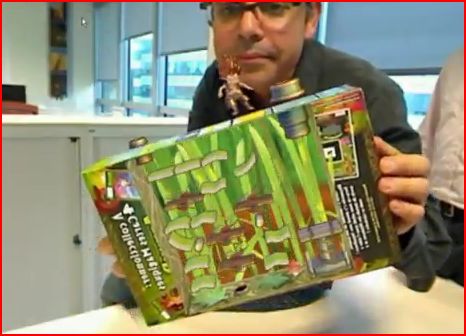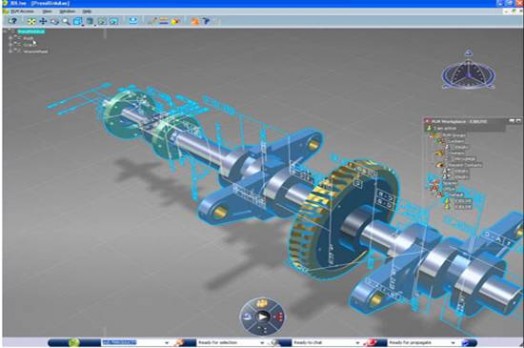The company best known for the software behind the all-digital design of the Boeing 777 wants to extend 3D to every commercial domain. Will Dassault next become known as the company that turned cereal box into game controllers?
By Randall S. Newton
Contributing Analyst, Jon Peddie Research
Take a look at the video embedded below before you continue with the rest of the article. Or just be lazy and look at the images below it. They show the use of a cereal box to play a computer game. The images on and surrounding the box are an example of 3D augmented reality, created using software tools from Dassault Systemes. The box was part of a successful promotion in Europe last year, tied to the movie “Arthur and the Minimoys.” Dassault executives say stores couldn’t keep the cereal in stock.


At the recent Dassault Systemes Customer Conference (DSCC) in Orlando, CEO Bernard Charles told key customers that just as it devoted the last 10 years to developing 3D technology for engineering, it will devote the next 10 years to creating “lifelike experiences for sustainable innovation.” The cereal-box-as-game-controller was a demonstration of how DS intends to deliver 3D out-of-the-box thinking (pun intended) for all commercial domains.
“We want to create experiences that open people’s minds to new possibilities,” says Charles. Building an engineering model in 3D is not enough, he argues, the entire product experience must be presented as 3D lifelike representation. During his main stage presentation to open DSCC, Charles presented examples actual and suggested from a variety of markets, including health care, life sciences, consumer packaged goods, durable goods, process and power, and aeronautics & defense.
Throughout the conference, Dassault employees and the various customers who spoke filled in the details on the Dassault vision, a path from today’s PLM to a future “lifelike” product experience. The three-layer foundation is Create-Manage-Share, using the current generation of DS technology, known as V6. The product design and engineering tools such as Catia, SolidWorks, and Simulia are the Creation tools, Enovia product data management technology is the Manage layer, and the suite of products known as 3Dvia are the “Share with lifelike experiences” layer. Using these technologies, DS says its customers can take the full product experience wherever it needs to go, whether that is on site, on the cloud, on mobile, or throughout an extended enterprise.

CEO Charles—more lively and animated than I have seen him in years—encouraged his audience to get started with this next level of 3D for business by buying and using 3Dvia Composer, a tool for creating 3D technical documentation. “Buy this, so we can go on to the next steps,” said Charles, with a smile. “I’m serious here!” To underline the idea that moving beyond 3D for engineering takes a bit of boldness, Charles said it wasn’t easy to get the developers of all Dassault products, including Catia and Solidworks, to add a “Save to 3Dvia” command. “It is a mindset change for us, as well,” he admitted.
Search-based applications
For most attendees, DSCC was their introduction to Dassault’s most recent acquisition, Exalead, a French maker of search technology. Dassault plans to incorporate Exalead technology throughout its product line by adding search capabilities wherever beneficial. Charles says Exalead was underfunded when it was acquired, yet it had achieved a milestone of having indexed 20 billion web pages on 100 servers. By comparison, Google is estimated to have more than 1 million servers, although Google now does much more than serve up searches. Such economy of scale makes it possible for Exalead to put an up-to-date index of the entire World Wide Web inside a corporate firewall.
As a stand-alone business, Exalead is deployed by businesses and government agencies wanting world-class search capability behind the firewall. The US Army is the most recent customer, deploying Exalead CloudView as the primary search engine for the Combined Arms Center at Fort Leavenworth, Kansas, with results displayed in Microsoft SharePoint.
Dassault is hoping the availability of search-based applications will change how customers look at their data. Charles told of taking an Exalead demo to a large Tier 2 automotive manufacturer—not a Dassault customer—and showed them how fast and how completely they could search all their DWG files, including the text inside. The response, Charles says, was “When can we have this?”
Loving Catia
One of the many customers presenting at DSCC was Ford Motor Company. Robert Trecapelli shared how Ford has improved a variety of engineering processes since standardizing on Catia V5 in 2005. Ford has implemented a “Final Data Judgment” process whereby a part has a single point of release to manufacturing or supply chain management. Ford now has more than 25,000 engineering templates for digital pre-assembly, whereby engineering and design requirements are validated geometrically.

Trecapelli said he was not allowed to divulge how many seats of Catia Ford has deployed, but he did say it is a rapidly growing number. He was able to quantify some points of progress between 2005 and 2010:
- 60% improvement in their on-time release of parts
- 95% reduction of geometric issues
- 4x reduction of post-release changes
- “a steep” but not publishable decline in engineering cycle times.
Michael Tellijohann explained the “digitizing P&G” initiative at Proctor & Gamble, the world’s largest consumer packaged goods manufacturer. To maintain organic sales growth of between 4% and 6% annually, P&G has to come up with between $3 billion and $4 billion in new business every year.
P&G has been using some form of PLM since the late 1990s, and by 2007 had a hodge-podge of non-integrated PLM and PDM systems. The company took an “IT time out” to reassess its PLM strategy. It realized it was already a PLM leader in CPG, but a PLM laggard in all of manufacturing. After a lengthy benchmark process, it decided to go with Dassault as a strategic partner, choosing the “one neck to choke” approach over shopping around for best-of-breed applications that would then need further integration. Tellijohann said P&G is very happy with its deployment. Engineers are not the key users of PLM at P&G, he noted. Packaging is a critical process, and it uses non-CAD graphics. P&G is now in the middle of deployment; it expects it will be another three or four years before they reap the full benefit of their plans for PLM.
Flow International of Seattle makes supersonic water jets as cutting tools. They shoot water at Mach 3.5. This month they moved from a mix of Pro/Engineering and SolidWorks to standardize on Catia V6 for engineering, and will install Enovia V6 shortly. “Complexity, set-up and support drive us to world-class PLM,” says Craig Sunada, Flow’s VP of global product development.
Some PLM vendors pitch Sunada the idea of standardizing on their data system first, and then said he could be “CAD agnostic” if he didn’t want their CAD product. “Being CAD agnostic doesn’t make sense,” Sunada told me. “You want tight integration. We made the vendors demonstrate out-of-the-box integration. V6 impressed us with the power of its deep integration.” PTC’s Windchill was in the running for a while, Sunada said, but “the power of integration and online 3D pushed us over the edge. Geometry stored in the database is the first competitive differential in PLM I’ve seen in years.”
Flow has offices in 50 countries, and Sunada envisions soon being able to put 3D parts and assemblies online and for smartphone access. “Online 3D as a univeral media will be powerful for us.”

Going for a SwYm
All this 3D lifelike experience stuff needs a place to be lifelike. Dasasult is rolling out Swym (for See What You Mean), an online workspace that is one part SharePoint, one part Facebook. You log in, create a workspace, and invite collaborators. Dassault VP Bruno Delahaye says Swym has been used internally for several months, with 90% of Dassault’s 10,000 employees now using the service.

I found it drag-and-drop simple to create a custom collaboration space when I tried it out. Delahaye says large accounts have been asking for this kind of 3D-friendly online resource. SharePoint is good at linking Microsoft Office documents, but isn’t built for this kind of user-friendly, 3D aware access.
Enovia V6 to the clouds
Ripples of disrespect have been sloshing around the industry since 2008, when Dassault first articulated its V6 plans. Mostly the critics focus on the nearly-impossible-to-ignore deep integration between Catia V6 the CAD solution and Enovia V6 the data manager. Besides generally ignoring the critics, Dassault has been working to take that deep integration and expand its usefulness.
Coming soon are two cloud-based initiatives based on Enovia V6. The first is the ability to create a new cloud-based Enovia V6 server. DS people we talked to stressed the simplicity by which a new project could be launched online using this new service. Then users of Catia, SolidWorks, Simulia, etc. could be linked up to the one project, no matter their location, without the typical IT hassles.
The second is something code-named SolidWorks Connect. The concept was first introduced to SolidWorks users in February 2010 at SolidWorks World. (See our article “Coming Soon to SolidWorks: Enovia and Catia.”) SolidWorks CEO Jeff Ray was at DSCC, the first time SolidWorks participated in this event. As Ray told the DSCC audience, “This online CAD-based collaboration tool is planned for early 2011 and is specifically designed for smaller companies and individual users who need to easily upload, organize, and share designs—many times at a moment’s notice.” The SolidSmack blog quotes SolidWorks founder Jon Hirschtick (now a Dassault “group executive”) as saying, “the upcoming Connect offering will be our first online app … purely optional for SolidWorks customers and offered in addition to our existing data management solutions. It’s intended for customers who want and need a data management solution, but can’t support the IT resources required.”
What we think
Manufactures buy software from Dassault Systemes for the same reason consumers buy Apple products. There are less expensive solutions, and there are ways to mix and match products to do the same tasks. But the idea of one technology partner who is always a step head of you and seems to have everything you need all integrated is very appealing.
Dassault made it clear at DSCC they intend to expand their market, targeting a variety of industries not now associated with PLM the way aero, auto, defense, and high tech are today. It even rather boldly has AEC in its sights. It certainly has the technology vision and the war chest (more than $1 billion in cash) to execute its plans. The cereal box augmented reality game controller is not only a clever bit of cooperative marketing, it is a message to customers that Dassault understands the needs of CPG companies.
Enovia V6 in the cloud could be the tipping point. More than 75% of all engineering and manufacturing firms either have no data management in place, or they have rudimentary and outdated file management systems. If enough companies decide Enovia V6 offers world-class engineering data management without the IT headaches and without compromising IP, it could be a game changer. Dassault doesn’t need to steal those few PLM-savvy manufacturers away from PTC, Siemens, Oracle, or SAP; they just need to reach the majority who need to leapfrog their engineering systems into the 21st Century.
One more thing: Bernard Charles dropped hints at DSCC about the next agenda. “Supply chain management is so boring,” he said more than once.





